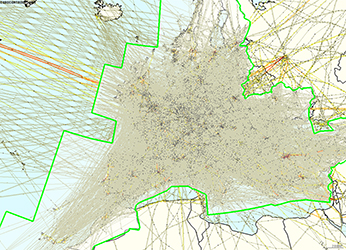CROSS-BORDER FREE ROUTES IMPROVE PREDICTABILITY AND REDUCE FUEL CONSUMPTION
The free routing concept allows airspace users to plan flight trajectories without reference to a fixed route network so they can optimise their flights in line with their individual business needs. Building on previously research, this solution extends to cross-border operations and very high complexity upper airspace.
Rather than target unrestricted free routing operations, this solution focuses on the improvement of separation provision and aims at enabling safe and efficient operations with minimum structural limits. The solution also relies on the Network Management (NM) function to cope with any demand and capacity imbalances created from changes in dominant traffic flows in free route airspace through the monitoring of the traffic complexity levels together with the level of the traffic demand.
SESAR validated two applications using real-time simulations combined with an upgraded flight data processing system and enhanced controller tools to support conflict detection and resolution. The objective was to assess the impact of the solution on fuel efficiency and predictability and confirm the absence of any negative impact on safety and capacity. Human Performance aspects were also assessed.
The validation exercises results show that the implementation of structurally limited cross-border free routing in high and very high complexity environment has no negative impact on controllers’ performance when assisted by appropriate ATC support tools. Airspace safety and capacity is also maintained. The environmental benefits are significant, with an estimated reduction in average fuel burn per flight of 26,57 kg within the 2035 timeframe.
Airspace users gain maximum benefit when free routing is supported by appropriate cross-border airspace design. This recommendation goes along with the outcomes of the Airspace Architecture Study, which highlights the importance of “an optimal flow centric redesign of airspace sectors” as a support for “a seamless free route airspace for the whole ECAC region”.
The solution is available for industrialisation and is part of Europe-wide synchronised deployment. To date, the solution has been implemented in the following countries: Albania, Austria, Bulgaria, Croatia, Denmark, Estonia, Germany, Hungary, Ireland, Latvia, Maastricht UAC, Moldova, Montenegro, Bosnia and Herzegovina, North Macedonia, Norway, Romania, Serbia, Slovakia, Slovenia and Sweden.
BENEFITS
- Optimised flight trajectories
- Reduced fuel consumption for airspace users
- Safety and capacity maintained
DATAPACKS
- SESAR Solution PJ_06-01 Contextual Note v2.1
- PJ.06-D2.1.110 - PJ06-01 TS-IRS Check (V3) Final Version
- PJ06-D2_1_200 - PJ_06-01 CBA (V3) v00_01_00
- PJ06-D2_1_030 - Part II - Final Safety Assessment Report
- PJ06-D2_1_030 - Part IV - Human Performance Assessment Report
- PJ06-D2_1_030 - Part V - Performance Assessment Report
- PJ06-D2_1_030 V3 SPR INTEROP OSED Final Version - Part I

